height Hyundai Kona 2018 Owner's Manual - RHD (UK, Australia)
[x] Cancel search | Manufacturer: HYUNDAI, Model Year: 2018, Model line: Kona, Model: Hyundai Kona 2018Pages: 497, PDF Size: 11.7 MB
Page 20 of 497
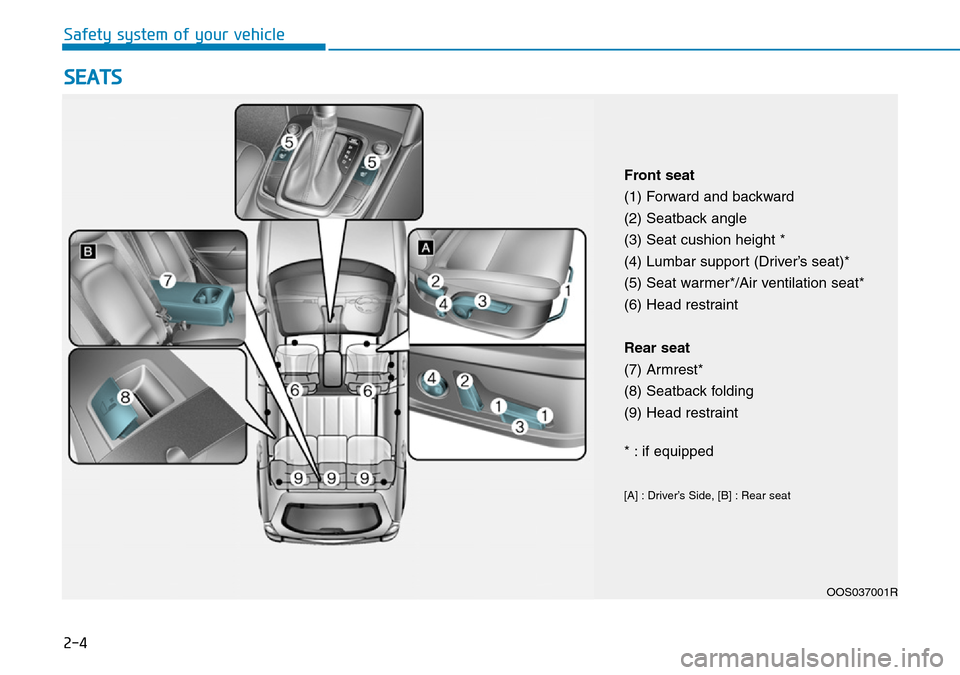
2-4
SEATS
Safety system of your vehicle
Front seat
(1) Forward and backward
(2) Seatback angle
(3) Seat cushion height *
(4) Lumbar support (Driver’s seat)*
(5) Seat warmer*/Air ventilation seat*
(6) Head restraint
Rear seat
(7) Armrest*
(8) Seatback folding
(9) Head restraint
* : if equipped
[A] : Driver’s Side, [B] : Rear seatOOS037001R
Page 24 of 497
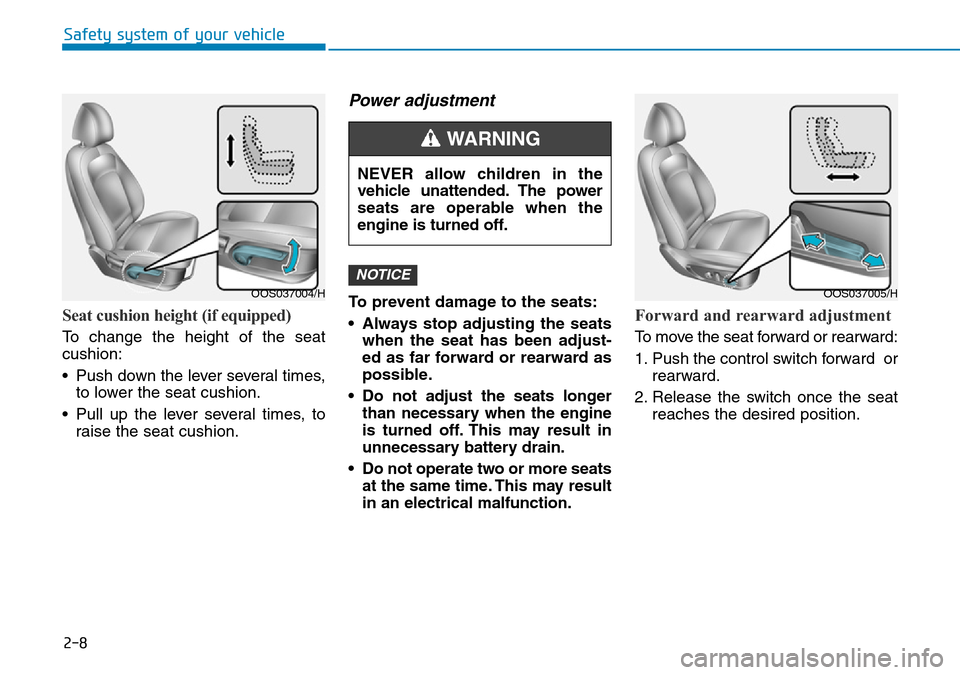
2-8
Safety system of your vehicle
Seat cushion height (if equipped)
To change the height of the seat
cushion:
• Push down the lever several times,to lower the seat cushion.
• Pull up the lever several times, to raise the seat cushion.
Power adjustment
To prevent damage to the seats:
• Always stop adjusting the seatswhen the seat has been adjust-
ed as far forward or rearward as
possible.
• Do not adjust the seats longer than necessary when the engine
is turned off. This may result in
unnecessary battery drain.
• Do not operate two or more seats at the same time. This may result
in an electrical malfunction.Forward and rearward adjustment
To move the seat forward or rearward:
1. Push the control switch forward or rearward.
2. Release the switch once the seat reaches the desired position.
NOTICE
OOS037004/H
NEVER allow children in the
vehicle unattended. The power
seats are operable when the
engine is turned off.
WARNING
OOS037005/H
Page 26 of 497
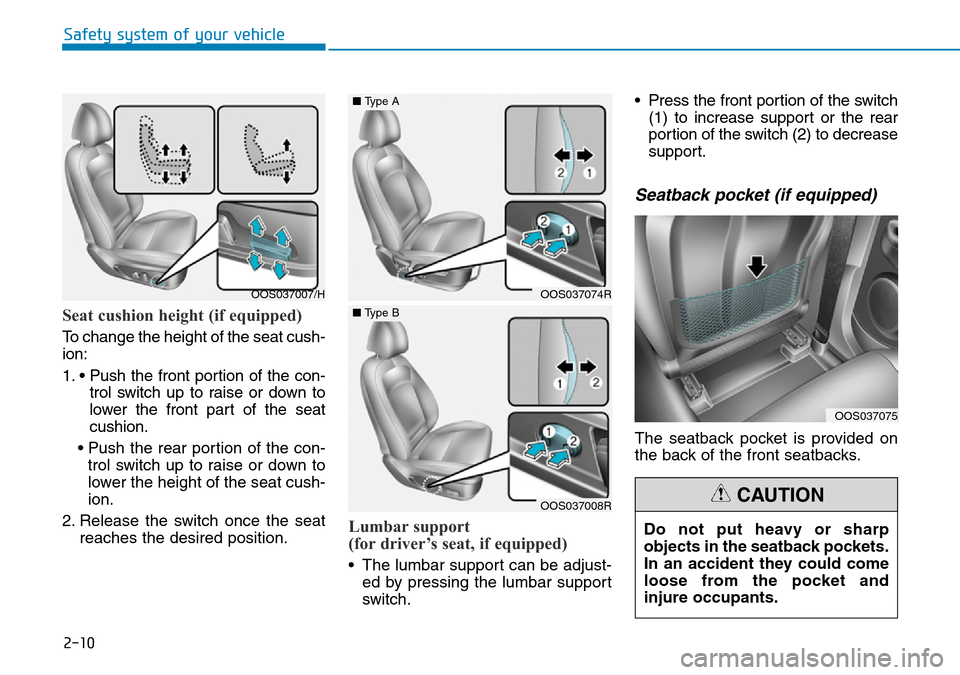
2-10
Safety system of your vehicle
Seat cushion height (if equipped)
To change the height of the seat cush-
ion:
1. • Push the front portion of the con-trol switch up to raise or down to
lower the front part of the seat
cushion.
• Push the rear portion of the con- trol switch up to raise or down to
lower the height of the seat cush-
ion.
2. Release the switch once the seat reaches the desired position.
Lumbar support
(for driver’s seat, if equipped)
• The lumbar support can be adjust-ed by pressing the lumbar support
switch. • Press the front portion of the switch
(1) to increase support or the rear
portion of the switch (2) to decrease
support.
Seatback pocket (if equipped)
The seatback pocket is provided on
the back of the front seatbacks.
OOS037007/H
OOS037075
Do not put heavy or sharp
objects in the seatback pockets.
In an accident they could come
loose from the pocket and
injure occupants.
CAUTION
OOS037074R
■ Type A
OOS037008R
■Type B
Page 30 of 497
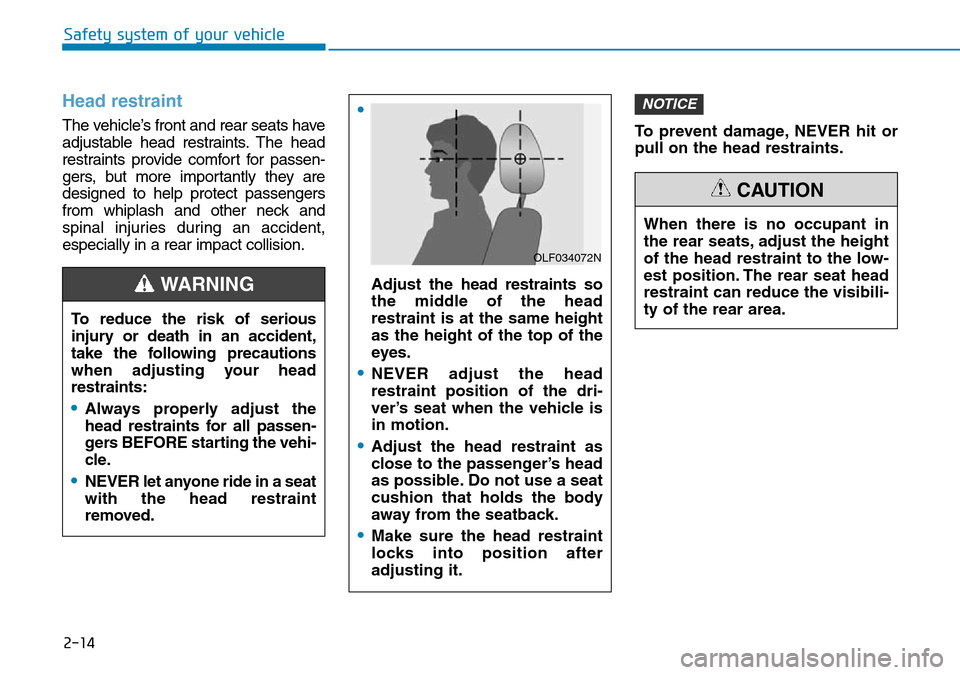
2-14
Safety system of your vehicle
Head restraint
The vehicle’s front and rear seats have
adjustable head restraints. The head
restraints provide comfort for passen-
gers, but more importantly they are
designed to help protect passengers
from whiplash and other neck and
spinal injuries during an accident,
especially in a rear impact collision.To prevent damage, NEVER hit or
pull on the head restraints.
NOTICE
To reduce the risk of serious
injury or death in an accident,
take the following precautions
when adjusting your head
restraints:
•Always properly adjust the
head restraints for all passen-
gers BEFORE starting the vehi-
cle.
•NEVER let anyone ride in a seat
with the head restraint
removed.
WARNING
•
Adjust the head restraints so
the middle of the head
restraint is at the same height
as the height of the top of the
eyes.
•NEVER adjust the head
restraint position of the dri-
ver’s seat when the vehicle is
in motion.
•Adjust the head restraint as
close to the passenger’s head
as possible. Do not use a seat
cushion that holds the body
away from the seatback.
•Make sure the head restraint
locks into position after
adjusting it.
OLF034072N
When there is no occupant in
the rear seats, adjust the height
of the head restraint to the low-
est position. The rear seat head
restraint can reduce the visibili-
ty of the rear area.
CAUTION
Page 31 of 497
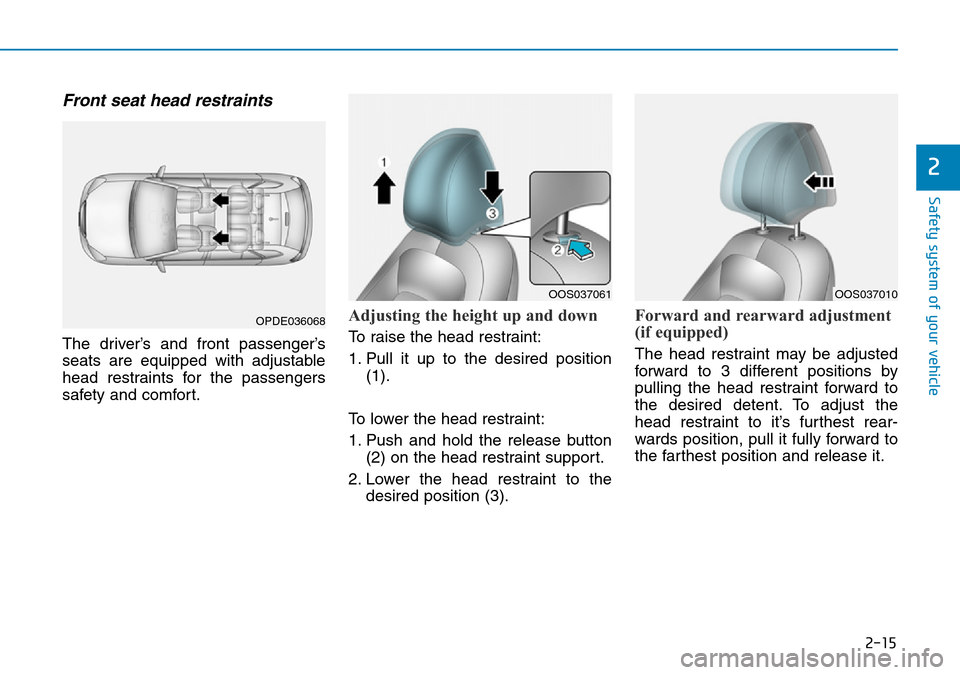
2-15
Safety system of your vehicle
2
Front seat head restraints
The driver’s and front passenger’s
seats are equipped with adjustable
head restraints for the passengers
safety and comfort.
Adjusting the height up and down
To raise the head restraint:
1. Pull it up to the desired position(1).
To lower the head restraint:
1. Push and hold the release button (2) on the head restraint support.
2. Lower the head restraint to the desired position (3).
Forward and rearward adjustment
(if equipped)
The head restraint may be adjusted
forward to 3 different positions by
pulling the head restraint forward to
the desired detent. To adjust the
head restraint to it’s furthest rear-
wards position, pull it fully forward to
the farthest position and release it.
OPDE036068
OOS037061OOS037010
Page 33 of 497
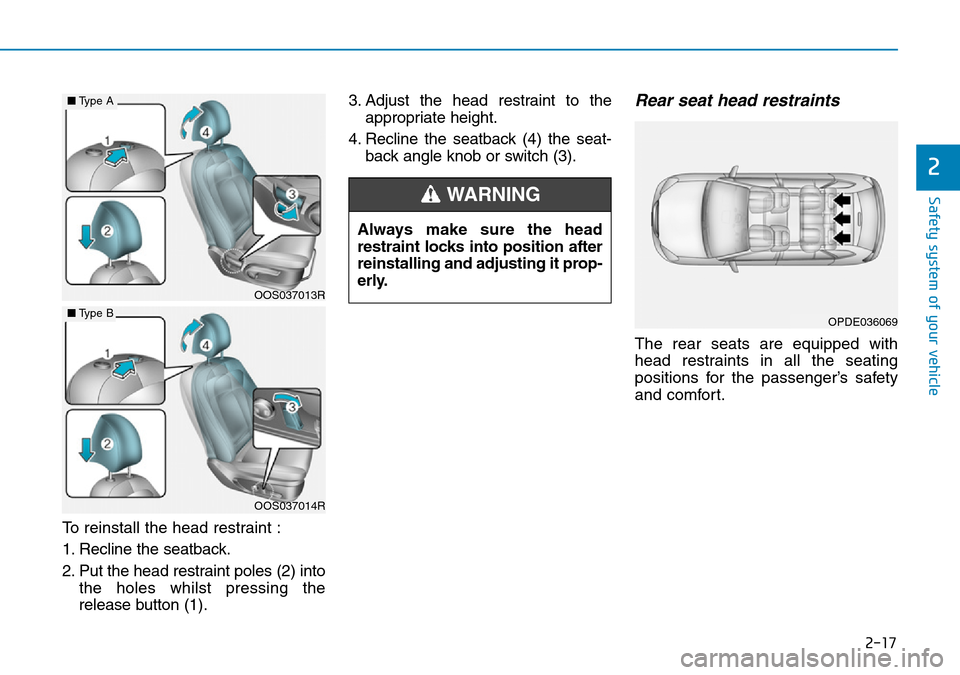
2-17
Safety system of your vehicle
2
To reinstall the head restraint :
1. Recline the seatback.
2. Put the head restraint poles (2) intothe holes whilst pressing the
release button (1). 3. Adjust the head restraint to the
appropriate height.
4. Recline the seatback (4) the seat- back angle knob or switch (3).
Rear seat head restraints
The rear seats are equipped with
head restraints in all the seating
positions for the passenger’s safety
and comfort.
OPDE036069
Always make sure the head
restraint locks into position after
reinstalling and adjusting it prop-
erly.
WARNING
OOS037013R
OOS037014R
■Type A
■Type B
Page 34 of 497
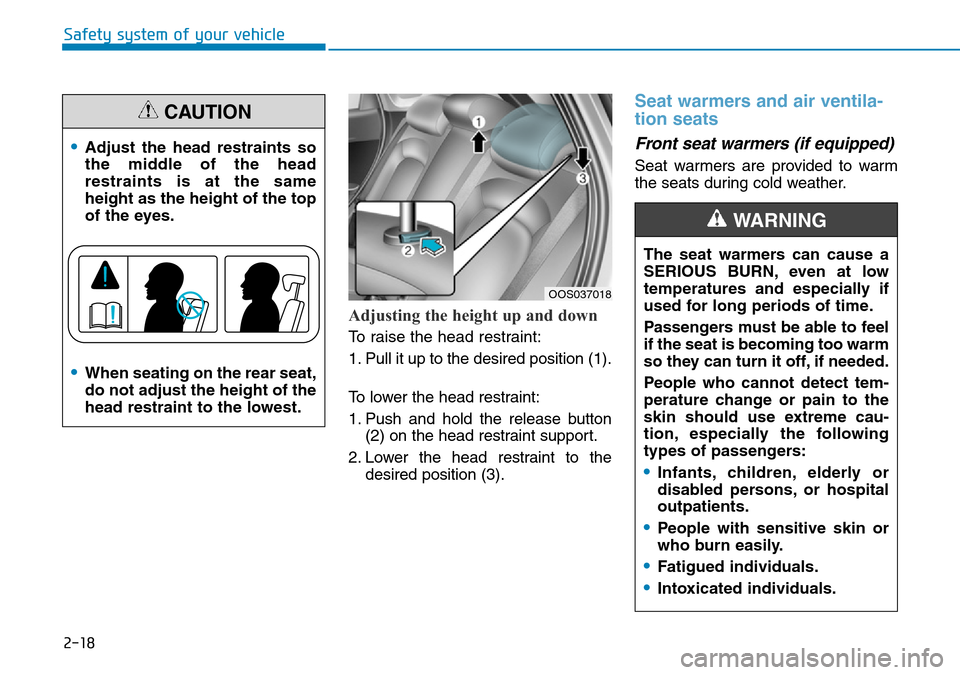
2-18
Safety system of your vehicle
Adjusting the height up and down
To raise the head restraint:
1. Pull it up to the desired position (1).
To lower the head restraint:
1. Push and hold the release button(2) on the head restraint support.
2. Lower the head restraint to the desired position (3).
Seat warmers and air ventila-
tion seats
Front seat warmers (if equipped)
Seat warmers are provided to warm
the seats during cold weather.
The seat warmers can cause a
SERIOUS BURN, even at low
temperatures and especially if
used for long periods of time.
Passengers must be able to feel
if the seat is becoming too warm
so they can turn it off, if needed.
People who cannot detect tem-
perature change or pain to the
skin should use extreme cau-
tion, especially the following
types of passengers:
•Infants, children, elderly or
disabled persons, or hospital
outpatients.
•People with sensitive skin or
who burn easily.
•Fatigued individuals.
•Intoxicated individuals.
WARNING
OOS037018
•Adjust the head restraints so
the middle of the head
restraints is at the same
height as the height of the top
of the eyes.
•When seating on the rear seat,
do not adjust the height of the
head restraint to the lowest.
CAUTION
Page 41 of 497
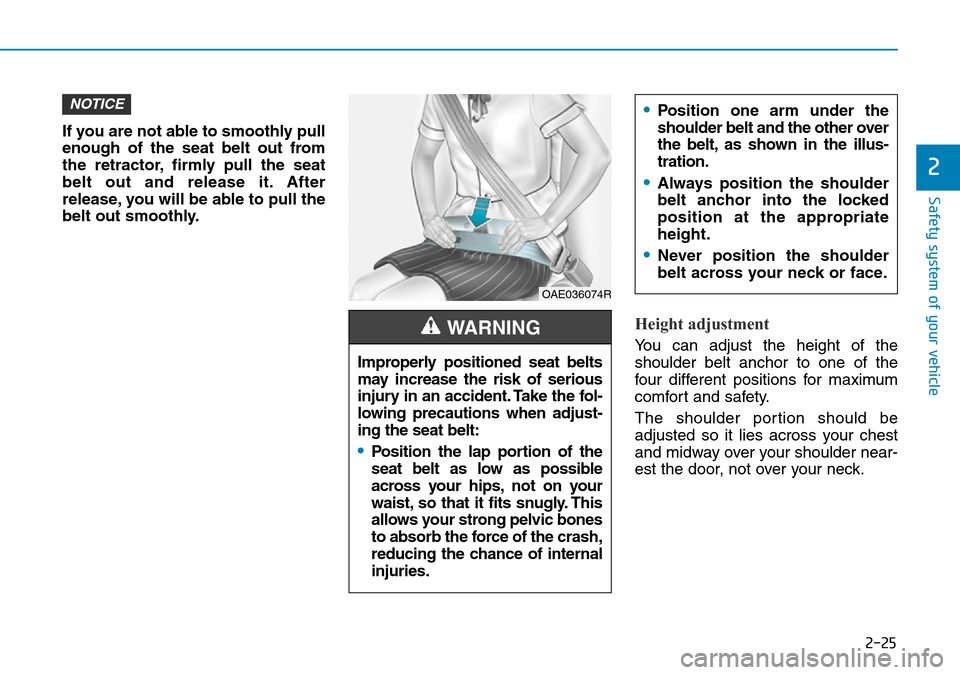
2-25
Safety system of your vehicle
2
If you are not able to smoothly pull
enough of the seat belt out from
the retractor, firmly pull the seat
belt out and release it. After
release, you will be able to pull the
belt out smoothly.
Height adjustment
You can adjust the height of the
shoulder belt anchor to one of the
four different positions for maximum
comfort and safety.
The shoulder portion should be
adjusted so it lies across your chest
and midway over your shoulder near-
est the door, not over your neck.
NOTICE
OAE036074R
Improperly positioned seat belts
may increase the risk of serious
injury in an accident. Take the fol-
lowing precautions when adjust-
ing the seat belt:
•Position the lap portion of the
seat belt as low as possible
across your hips, not on your
waist, so that it fits snugly. This
allows your strong pelvic bones
to absorb the force of the crash,
reducing the chance of internal
injuries.
WARNING
•Position one arm under the
shoulder belt and the other over
the belt, as shown in the illus-
tration.
•Always position the shoulder
belt anchor into the locked
position at the appropriate
height.
•Never position the shoulder
belt across your neck or face.
Page 42 of 497
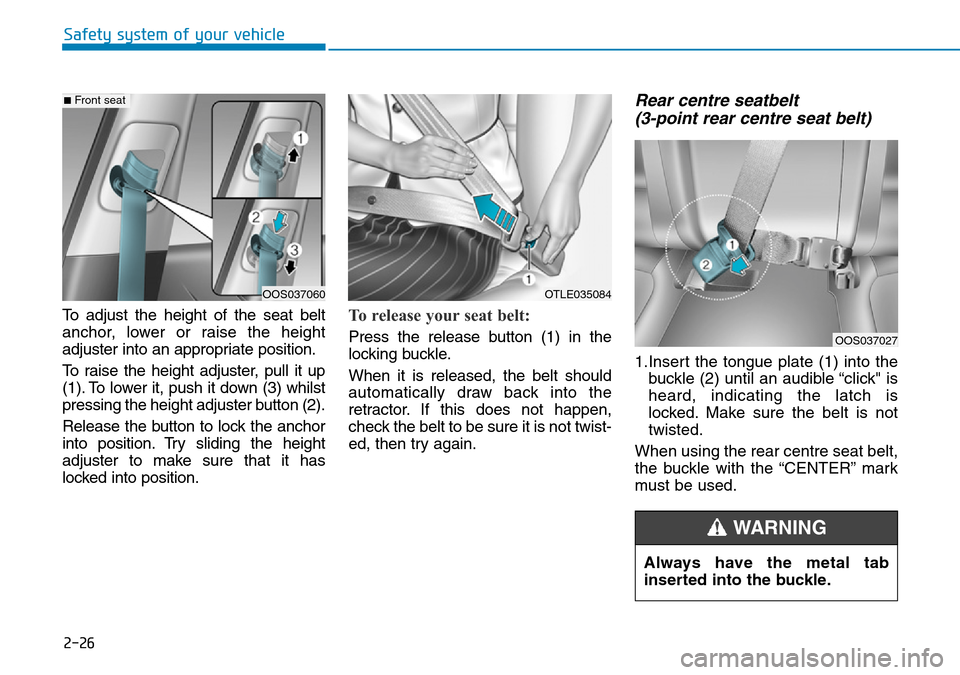
2-26
Safety system of your vehicle
To adjust the height of the seat belt
anchor, lower or raise the height
adjuster into an appropriate position.
To raise the height adjuster, pull it up
(1). To lower it, push it down (3) whilst
pressing the height adjuster button (2).
Release the button to lock the anchor
into position. Try sliding the height
adjuster to make sure that it has
locked into position.
To release your seat belt:
Press the release button (1) in the
locking buckle.
When it is released, the belt should
automatically draw back into the
retractor. If this does not happen,
check the belt to be sure it is not twist-
ed, then try again.
Rear centre seatbelt (3-point rear centre seat belt)
1.Insert the tongue plate (1) into the
buckle (2) until an audible “click" is
heard, indicating the latch is
locked. Make sure the belt is not
twisted.
When using the rear centre seat belt,
the buckle with the “CENTER” mark
must be used.
OOS037060
■Front seat
OTLE035084
OOS037027
Always have the metal tab
inserted into the buckle.
WARNING
Page 46 of 497
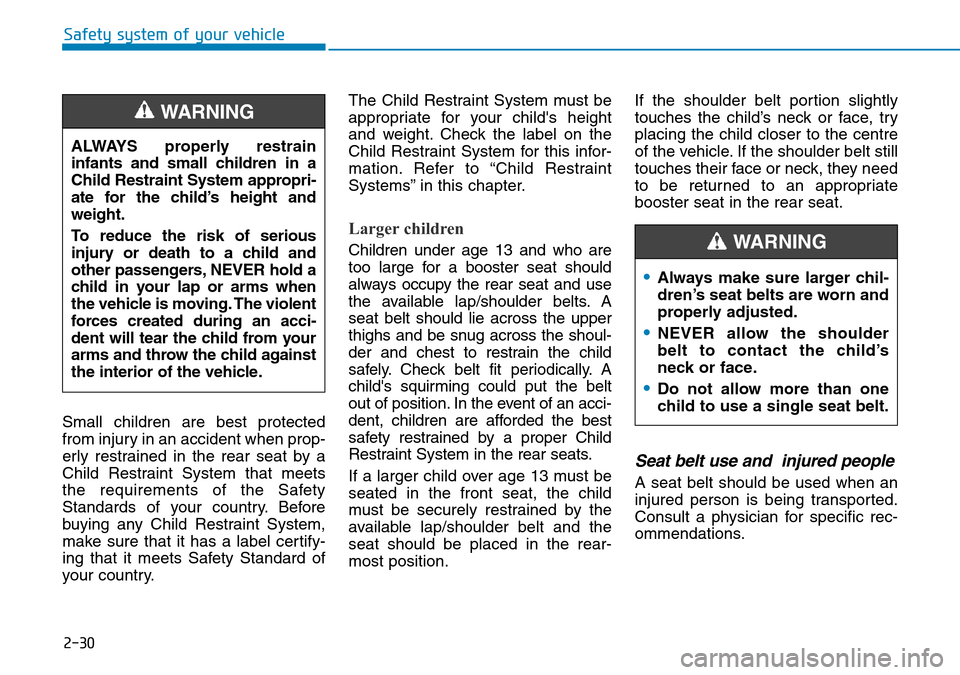
2-30
Safety system of your vehicle
Small children are best protected
from injury in an accident when prop-
erly restrained in the rear seat by a
Child Restraint System that meets
the requirements of the Safety
Standards of your country. Before
buying any Child Restraint System,
make sure that it has a label certify-
ing that it meets Safety Standard of
your country. The Child Restraint System must be
appropriate for your child's height
and weight. Check the label on the
Child Restraint System for this infor-
mation. Refer to “Child Restraint
Systems” in this chapter.
Larger children
Children under age 13 and who are
too large for a booster seat should
always occupy the rear seat and use
the available lap/shoulder belts. A
seat belt should lie across the upper
thighs and be snug across the shoul-
der and chest to restrain the child
safely. Check belt fit periodically. A
child's squirming could put the belt
out of position. In the event of an acci-
dent, children are afforded the best
safety restrained by a proper Child
Restraint System in the rear seats.
If a larger child over age 13 must be
seated in the front seat, the child
must be securely restrained by the
available lap/shoulder belt and the
seat should be placed in the rear-
most position.
If the shoulder belt portion slightly
touches the child’s neck or face, try
placing the child closer to the centre
of the vehicle. If the shoulder belt still
touches their face or neck, they need
to be returned to an appropriate
booster seat in the rear seat.
Seat belt use and injured people
A seat belt should be used when an
injured person is being transported.
Consult a physician for specific rec-
ommendations.
ALWAYS properly restrain
infants and small children in a
Child Restraint System appropri-
ate for the child’s height and
weight.
To reduce the risk of serious
injury or death to a child and
other passengers, NEVER hold a
child in your lap or arms when
the vehicle is moving. The violent
forces created during an acci-
dent will tear the child from your
arms and throw the child against
the interior of the vehicle.
WARNING
•Always make sure larger chil-
dren’s seat belts are worn and
properly adjusted.
•NEVER allow the shoulder
belt to contact the child’s
neck or face.
•Do not allow more than one
child to use a single seat belt.
WARNING